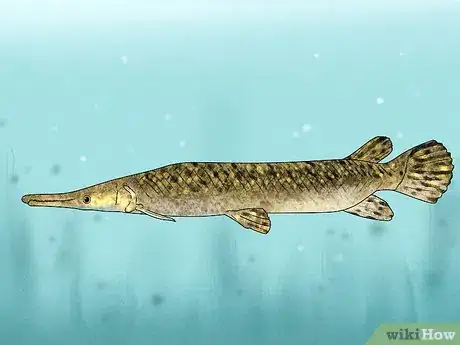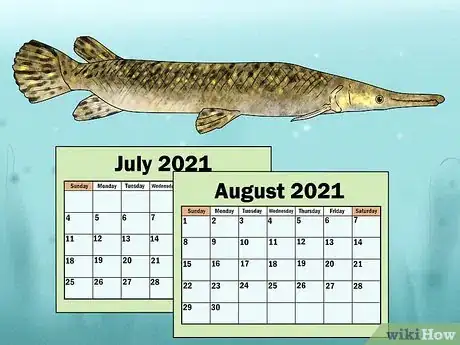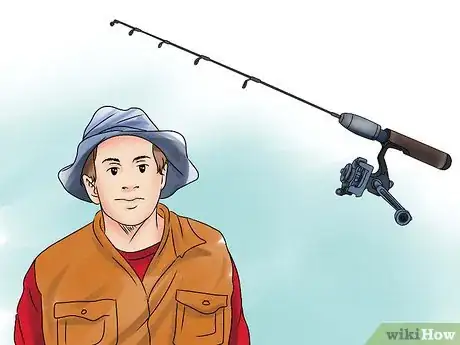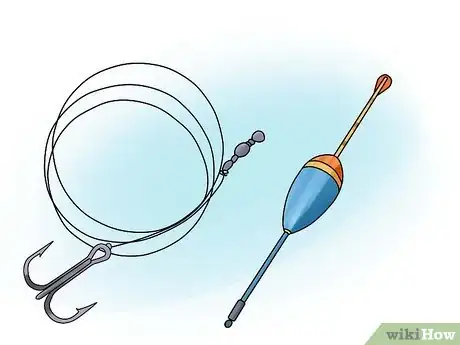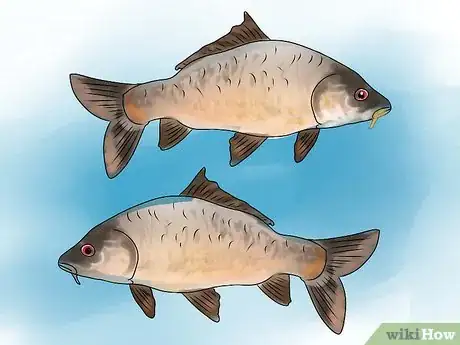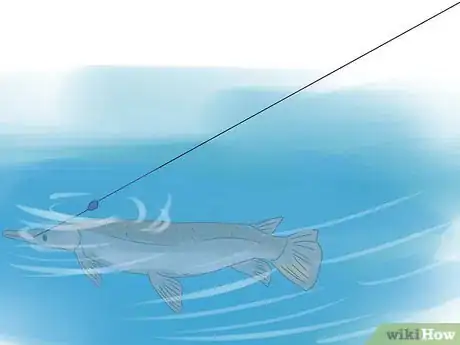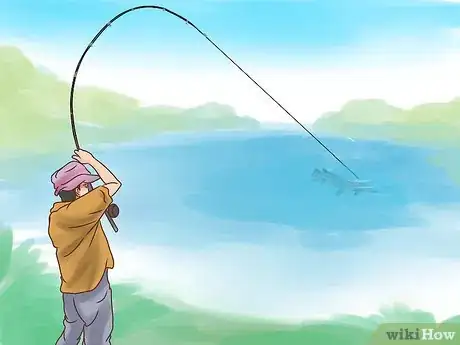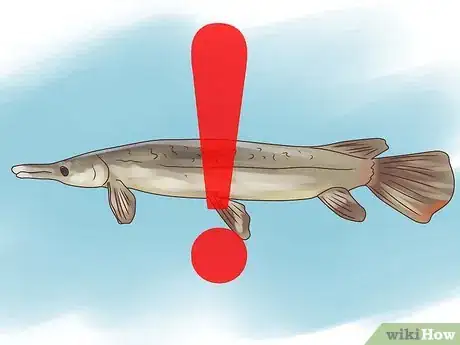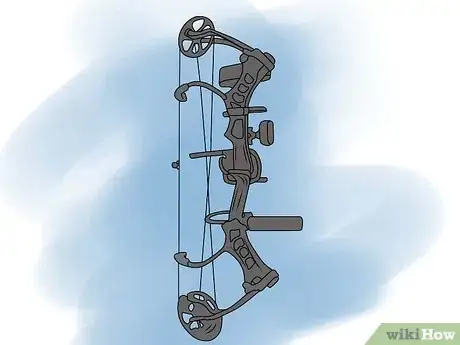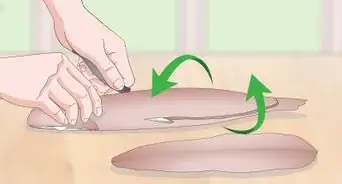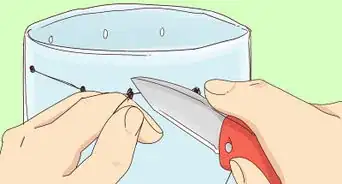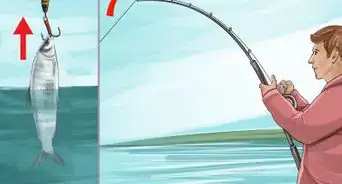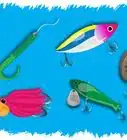wikiHow is a “wiki,” similar to Wikipedia, which means that many of our articles are co-written by multiple authors. To create this article, 27 people, some anonymous, worked to edit and improve it over time.
There are 9 references cited in this article, which can be found at the bottom of the page.
This article has been viewed 346,469 times.
Learn more...
The alligator gar is one serious fish. If you're interested in testing your mettle against a 100-pound, prehistoric-looking creature, and have access to the turbid slow-moving waters of the lower Mississippi River drainage area, then the alligator gar may just be the fish for you. Here are some tips for trying this toothy giant on for size.
Steps
Finding Alligator Gar
-
1Head to the American South. The gar thrives in the Mississippi river basin, from Southern Ohio and Illinois to the Gulf of Mexico. Mostly found in the freshwater bodies of Texas, Alabama, Louisiana, and Arkansas, the alligator gar is a distinctively Southern fish. As with many things, the biggest are generally found in Texas.[1]
- The Henderson Swamp west of Baton Rouge, Louisiana and Lake Pontchartrain, north of New Orleans, are populated with Alligator Gars.
- So are the Pearl and Pascagoula River in Mississippi, the Mobile, Tensaw, Tennessee, and Tombigbee Rivers in Alabama, and the Escambia, Choctawhatchee, and Apalachicola Rivers in the Florida panhandle.
- Texas rivers such as the Colorado, Trinity, Guadalupe, Sabine, and other main channels are most frequented and have the largest record gars to date, as well as the largest known populations of alligator gar.
-
2Find a slough or backwater. A "dead lake" is a lake that is inundated by an adjacent river when the water is high, but is landlocked when the river is at a normal level. This is the perfect kind of place to fish for gar. Secure permission to fish this water, and whatever licenses are required in the jurisdiction you are fishing in.[2]
- You will need to have access to fish your choice of locations, so if there is no bank access, you may have to secure a boat.
Advertisement -
3Learn to spot the 'gator gar. The alligator gar is just one species of gar, a long-nosed, sharp-toothed, distinctively prehistoric fish. They can weigh over 250 lbs and can survive up to two hours above water. The gator is the largest species of gar, and is the largest exclusively freshwater fish in North America. It can be as long as eight to ten feet, and the current world record for the largest alligator gar caught on rod and reel is 279lb 0oz. The largest taken by Bowfishing is 365lb.[3]
- If the gar's snout is more than twice the length of its head, and is no more than a few inches wide, it's probably a longnose gar.
- Florida gars and spotted gars have shorter snouts and are covered with distinctive, brownish spots.
- The alligator gar—your target—is the largest of these fish. It has a broader nose than the long nose, with two rows of teeth where the other gar have one. It can be quite large.
-
4Know when and where to look. The gar spawns in brackish waters in spring, around April, but the best time for hunting them is in late summer, when it is hot and dry.[4]
- In July and August, alligator gar can be found in deep river bends adjacent to relatively shallow pools. The deep water is where the gar congregate, and the shallow water will allow you to spot them more easily when they come up to feed.
Fishing for Gar
-
1Make sure your rig is up to the task. If you're going to try to hook a fish that weighs up to 250 pounds and has dozens of sharp, needle-like teeth, you're going to want more than a branch and bobber. Bring a stiff composite rod with strong test line. This is the kind of fish you'll want to bring up to the surface, so using a bobber for your bait is appropriate.[5]
- It's best to have a large open-faced or spinning reel capable of hold 150–200 yards (137.2–182.9 m) of 30-100 pound test monofilament line. A stiff-actioned graphite or composite rod, six or eight feet long is appropriate for this size of fish.
-
2For line, you'll want two-three feet of steel leader, and 40-80 pound test line.
- Hook bait onto a 6/0 treble hook and use a 1/4 oz. slip sinker, with a split shot sinker to keep it above the hook.
- Plastic or cork bobber (float), capable of keeping your bait and rig suspended near the water's surface.
-
3Bring a good-sized live bait. Some people in the lower delta waters near the Gulf Coast prefer 10–12 inch (25.4–30.5 cm) mullet, and often suggest removing the scales before using them, but any legal baitfish, such as shiners, shad, or suckers are on the gar's menu.[6]
- Carp, buffalo, and large perch are also commonly used.
-
4Watch for schooling baitfish, like shad, shiners, or freshwater mullet. When you spot a school of fish breaking the water as if they are being herded by a hungry carnivore, you are probably in gar country. Rig your bait, and cast.
-
5Cast into the deep part of the channel. Leave the spool open to allow the gar to take the bait and run with it for a few clicks. Keep your eye on the float. When it begins to torpedo across the top of the water, or when it dives towards the depths, you know you've got a gar on the line. Lower your rod toward it, and wait at least seven seconds after the line pulls tight.
- The gar swims with its food before attempting to eat it. If you try to set the hook to early, you'll risk jostling it loose or hooking the gar in a less-than-optimum spot.
-
6Set the hook. The alligator gar has a hard, bony plate in its mouth, which is the reason fishermen prefer treble hooks, and considerable force is needed to penetrate it. To ensure that you set the hook in the soft, secure part of the gar's mouth, you may have to set it a few times. Since you've let as much as a few hundred yards of line spool out, this may take considerable strength and a few pulls.[7]
- When you've got your hook set, it's time to settle in for a big wrestling match.
Fighting the Gar
-
1Assess the fish when you feel the tension on your line. Very large fish will require a substantial fight to land, and you may find it necessary to adjust your drag to wear it down. Try to keep the fish steered away from logs, brush, or other snags to keep him from becoming tangled, where you will almost certainly lose him.
-
2Fight your fish until it is exhausted. Bring it in a bit at a time, letting the gar wear itself out. Don't expend more energy than necessary bringing it in quickly. Never try to force even a smaller gar into the boat while it still has fight left in it. The alligator gar has been known to bite aggressively in self-defense. For very large gar, it may be best to gill gaff them, so that the head (and teeth) can be steered away from occupants of the boat before bringing it aboard.
- A gill gaff is basically a pole with a sharp hook on the end, for snaring large fish beside the boat. Generally, a partner will hook the fish through the gills and under the backbone, probably wounding the fish mortally. If you want to hook a gar and release it, don't do this.
-
3Be extremely careful if you choose to release your catch. Generally, fishermen don't recommend fishing for gar unless you intend to kill them. Bringing a live gar into the boat, or onto the shore, is extremely dangerous. Removing a treble hook from a mouth full of needle-like teeth requires a very long-nosed pair of pliers. Make sure the fish is beyond exhausted, and that you're wearing protective arm and hand gear if you attempt this.[8]
- Cutting the line will leave the treble hook embedded in the fish's mouth, leaving it little chance of survival.
- The alligator gar and many other freshwater predators are increasingly endangered. The best preservation policy with these fish is catch and release, so at least be aware of the difficulties of doing so if you want to hunt gar responsibly.
-
4Consider creative alternatives. Many southerners will tell you the preferred method of fishing for alligator gars is actually bow fishing, using a compound hunting bow and fishing arrows. Bow-fishing is much more exciting to many, as it combines fishing and hunting.[9]
- Some fishermen will likewise bring along a .22 to finish off the gar when it gets close to the boat. Be extremely careful and make sure that you're licensed if you're going to fish with hunting gear.
-
5Consider taking your gar home for dinner. Generally, the gar is a trophy fish, given its size and fierce look. It is an edible (some say tasty) fish, but quite difficult to clean. The scales are armor-like and all come off together, though, so it comes off with the right technique.[10]
- Nail the gar's head to a blank and work a knife from the tail up the backbone, loosening the scales. Cut the head and tail off, and then work your knife down the sides of the fish. The scales should come up like a crust around the flesh underneath. Gut the fish as you would any other.
Community Q&A
-
QuestionWhat type of boat is best to use on an alligator gar fishing trip?
 Community AnswerAlligator gar are incredibly sensitive to sound, so avoid a typical motorboat, as it will spook the fish. If you can, use a rowboat or drift boat. If you must use a motor or fan boat, pull to the shore when you arrive at the spot, and wait quietly for the fish to return before casting.
Community AnswerAlligator gar are incredibly sensitive to sound, so avoid a typical motorboat, as it will spook the fish. If you can, use a rowboat or drift boat. If you must use a motor or fan boat, pull to the shore when you arrive at the spot, and wait quietly for the fish to return before casting. -
QuestionHow do the fish eat?
 Community AnswerAlligator gar typically bite down on their prey and swim with it up to several minutes before attempting to swallow it. They swallow their prey whole.
Community AnswerAlligator gar typically bite down on their prey and swim with it up to several minutes before attempting to swallow it. They swallow their prey whole. -
QuestionCan I keep Alligator Gar as a pet?
 Community AnswerGar do not make good pets. They require a large amount of space to swim and too much food to make them suitable as a pet.
Community AnswerGar do not make good pets. They require a large amount of space to swim and too much food to make them suitable as a pet.
Warnings
- Respect the teeth of this fish; never stick a hand, even with leather gloves, into its mouth.⧼thumbs_response⧽
Things You'll Need
- Heavy duty fishing tackle.
- Boat and motor are optional but preferred.
References
- ↑ http://www.totalfisherman.com/alligator_gar.html
- ↑ https://myfwc.com/research/freshwater/sport-fishes/alligator-gar/research/
- ↑ http://www.thejump.net/fishlist/alligatorgar.htm
- ↑ https://www.canr.msu.edu/news/late_summer_is_a_great_time_to_fish_for_gar_msg16_okeefe16
- ↑ https://tpwd.texas.gov/fishboat/fish/management/alligator-gar/gar-fishing.phtml
- ↑ https://www.garfish-texas.com/best-bait-for-alligator-gar
- ↑ https://tpwd.texas.gov/fishboat/fish/management/alligator-gar/gar-fishing.phtml
- ↑ https://tpwd.texas.gov/fishboat/fish/management/alligator-gar/no-threat.phtml
- ↑ https://tpwd.texas.gov/fishboat/fish/management/alligator-gar/who-fishes.phtml
About This Article
To fish for alligator gar, use a stiff-actioned graphite or composite rod that's 6-8 feet long with an open-faced reel and 40-80 pound test line. Next, bait a treble hook with a live mullet, shiner, shad, or sucker. Then, wait until you spot a school of fish breaking the water and cast your line into the deep part of the channel. When the float begins to torpedo across the top of the water or dips under the water's surface, lower your rod and let the line pull tight before setting the hook and reeling in your catch! For tips on exhausting a gar as you reel it in, read on!


